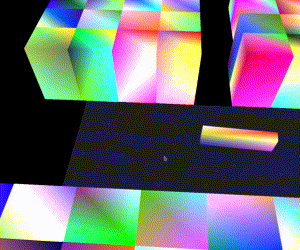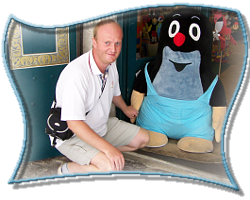
OpenGL
I've learnt a bit from WebGL first, so OpenGL is very similar. I've tried to make the program in C++ language under Linux.
There are several editor environment that can help you to handle the project, - like e.g. QT Creator, Netbeans IDE, Eclipse IDE, ... and so on, - but you can also write your code in a simple text editor like VI or KWrite. :-)
For my example to run must be installed GLEW and SFML libraries, for creating/compiling projects like this, you may need their devel packages and glm-devel.
my Struct for vertex data
/*
* 0 1 2 3 4 5 6 7 8 9
* posx, posy, posz, cred, cgreen, cblue, calpha, normx, normy, normz
*/
const int mySizes_position = 3;
const int mySizes_color = 4;
const int mySizes_normal = 3;
const int mySizes_index = 3;
const int mySizes_summ = mySizes_position + mySizes_color + mySizes_normal;
union myVertUnion {
GLfloat data[ mySizes_summ ];
struct myVertStruct {
GLfloat position[mySizes_position];
GLfloat color[mySizes_color];
GLfloat normal[mySizes_normal];
} vertex;
};my Vertex Shader:
attribute vec3 aVertexPosition;
attribute vec4 aVertexColor;
attribute vec3 aVertexNormal;
uniform mat4 uProjectionMatrix;
uniform mat4 uViewMatrix;
uniform mat4 uModelMatrix;
uniform vec3 uObjectMove;
uniform mat4 uNormalMatrix;
varying vec3 vNormal;
varying vec4 vColor;
void main() {
vNormal = mat3(uNormalMatrix) * aVertexNormal + uObjectMove;
vColor = aVertexColor;
vec4 modelPosition = vec4(aVertexPosition, 1.0f) * uModelMatrix + vec4( uObjectMove, 1.0f );
gl_Position = uProjectionMatrix * uViewMatrix * modelPosition;
}Each object has its own modelMatrix which contains a move and a scale before rotation and the end it is moveable by objectmove. I added the additional move to normal too, because of the distance change from light. Camera gives back the ViewMatrix.
An example how can I add objects with different settings:
this->AddObject( new myterrain() );
this->AddObject( new mycube() );
mycube *c2 = new mycube();
c2->setMoveVec( glm::vec3( 3,0,0 ) ); // -|
c2->setScaleVec( glm::vec3( 0.5,3,1 ) ); // -|==> these transforms implemented in
c2->setRotationVec( glm::vec3( 0,1,-1 ) ); // -| modelmatrix and normalmatrix too
c2->setMoveObject( glm::vec3( 5,-3,1 ) );
this->AddObject( c2 );
my Simple Camera:
/*
* (c)2023 Tóthpál István <istvan@tothpal.eu>
*/
#ifndef MYSIMPLECAM_H
#include "../inc/mysimplecam.h"
#endif
mysimplecam::mysimplecam( glm::vec3 pos, glm::vec3 front, glm::vec3 up ) {
defaultCameraPos = pos;
defaultCameraFront = front;
defaultCameraUp = up;
setSensitivity( 1.0f );
this->InitCamSettings();
}
mysimplecam::mysimplecam( glm::mat3 camdata ) {
defaultCameraPos = camdata[0];
defaultCameraFront = camdata[1];
defaultCameraUp = camdata[2];
setSensitivity( 1.0f );
this->InitCamSettings();
}
mysimplecam::~mysimplecam() {
}
void mysimplecam::InitCamSettings() {
cameraPos = defaultCameraPos;
cameraFront = defaultCameraFront;
cameraUp = defaultCameraUp;
stepSize = 0.05f;
this->RecalcVectors();
}
float mysimplecam::getSensitivity() {
return sensitivity;
}
void mysimplecam::setSensitivity( float s ) {
sensitivity = s;
}
void mysimplecam::RecalcVectors(){
cameraRight = glm::normalize(glm::cross(cameraUp, cameraFront));
cameraUp = glm::cross(cameraFront, cameraRight);
}
glm::mat4 mysimplecam::getViewMatrix(){
return glm::lookAt(
cameraPos,
cameraPos + cameraFront,
cameraUp
);
}
void mysimplecam::StepHorizontal(float way){
cameraPos += way * cameraRight * stepSize/(float)10 * sensitivity;
this->RecalcVectors();
}
void mysimplecam::StepForward(float way){
cameraPos += way * cameraFront * stepSize/(float)10 * sensitivity;
this->RecalcVectors();
}
void mysimplecam::StepLift(float way){
cameraPos += way * glm::cross(cameraFront,cameraRight) * stepSize/(float)10 * sensitivity;
this->RecalcVectors();
}
void mysimplecam::Yaw(float way){
cameraFront = glm::mat3(glm::rotate(glm::mat4(1.0f), glm::radians(way * stepSize * sensitivity), glm::cross(cameraFront,cameraRight) )) * cameraFront;
this->RecalcVectors();
}
void mysimplecam::Pitch(float way) {
cameraFront = glm::mat3(glm::rotate(glm::mat4(1.0f), glm::radians(way * stepSize * sensitivity), glm::cross(cameraFront, cameraUp) )) * cameraFront;
this->RecalcVectors();
}
void mysimplecam::Roll(float way) {
cameraUp = glm::mat3(glm::rotate(glm::mat4(1.0f), glm::radians(way * stepSize * sensitivity), cameraFront)) * cameraUp;
this->RecalcVectors();
}
I've created a simple test prog for trying my camera object. (generated a 10x10 terrain like thing from cubes) Here you can download executable in rpm package: MyGL-TIS-0.2.3-2.mga8.x86_64.rpm
Built on Mageia Linux 8, installing to bindir (/usr/bin/). (type MyGL-TIS to run)
(controls from keyboard: W/S step FW/BW; A/D Step L/R; Y/X Lift Up/Dn; Num8/2 rotate Up/Dn; Num4/6 rotate L/R; Num1/3 roll; R - reset pos )
Added simple mouse look and simple gamepad (joy 0) controll. (not fully implemented, just for a fast test, no settings, tried with a compatible cheap USB gamepad, mouse disabled if joy 0 detected) So I've just tried sf::Mouse and sf::Joystick here...
Built on Mageia Linux 9: MyGL-TIS-0.2.3-4.mga9.x86_64.rpm
References:
- My WebGL
- Khronos OpenGL® and OpenGL® ES Reference Pages (https://registry.khronos.org)
- Modern OpenGL Guide (https://open.gl)
- Learn OpenGL: https://learnopengl.com
- Fedora Packaging Tutorial: https://docs.fedoraproject.org
Physics
Usualy there not enough that the object looks great, just like in real life, it have to behave as in real circumstances. To reach that you may need to use physics. If you wouldn't like code everything, you can use an sdk. There are several physics sdk, I've started to learn Bullet.
In Mageia Linux 8 you can install lib64bullet and its devel package. For compiling your C++ code you have to add include path "/usr/include/bullet" and you may add BulletSoftBody, BulletDynamics, BulletCollision, LinearMath libraries.
Now I have to learn it, but fast I've implemented the example below to the previous code for trying the collision with the floor using gravity:

It's just a simple example, how a ball bounce, but not all we can do with physics.
I've forced Bullet Collision to my previous OpenGL code, so the cube reflecting/bouncing from other objects. Here you can download executable in rpm package: MyGL-TIS-Bullet-0.2.3-1.mga8.x86_64.rpm
Mageia 9 (using DOUBLE_PRECISION Bullet): MyGL-TIS-Bullet-0.2.3-1.mga9.x86_64.rpm
Built on Mageia Linux 8, installing to bindir (/usr/bin/). (type MyGL-TIS-Bullet to run)
(controls from keyboard: W/S step FW/BW; A/D Step L/R; Y/X Lift Up/Dn; Num8/2 rotate Up/Dn; Num4/6 rotate L/R; Num1/3 roll; R - reset pos, O - drop cube again)
References:
- Bullet physics sdk (at https://github.com)
- The HelloWorld example from Bullet (examples/HelloWorld/HelloWorld.cpp) and a very similar example: A simple example for Bullet collision (at https://stackoverflow.com/)

Menu
News
3D War game for Linux
You can play with historical vehicles (planes, tanks, ...) worldwide.
Fractal generation, Mandelbrot set, Julia set
WebGL TEST!
Simple test with a dualcone and more 3d objects:
23-07-2016
River fishing is an interesting way to catch fishes in a flowing water...
Me and my friends spent good days at Lake Warali in Baja.
17-05-2015
I tried different Lake, they say there are big fishes. Every time I had fished here I caught 4+ carps too.
may-2012
23-10-2011
03-10-2010
WARNING!!!
You can buy USB FLASH DRIVES and MP3/MP4/MP5 PLAYERS with FAKE memory sizes on the Internet!
Visitcount (since 2021-05-30): 0727